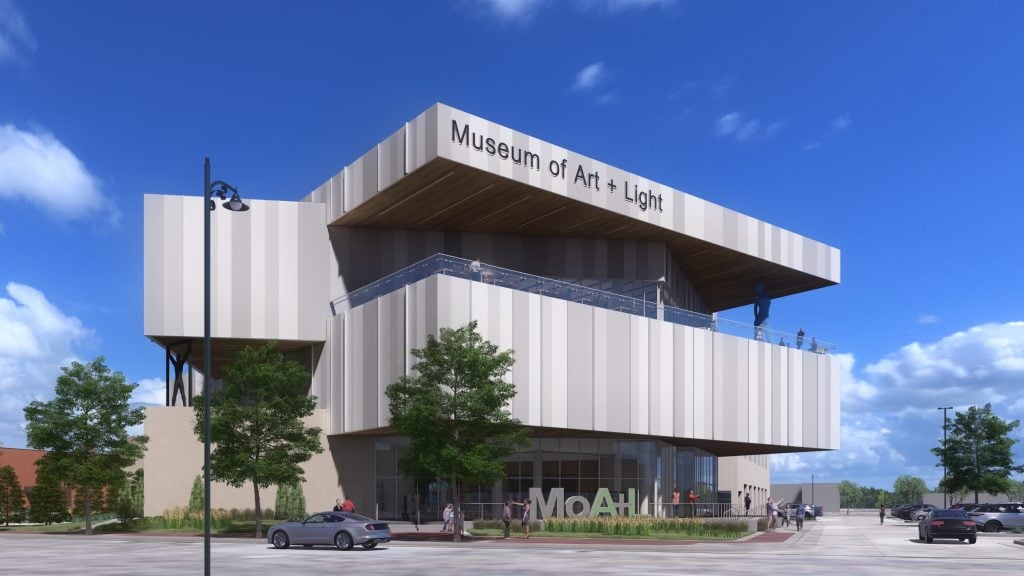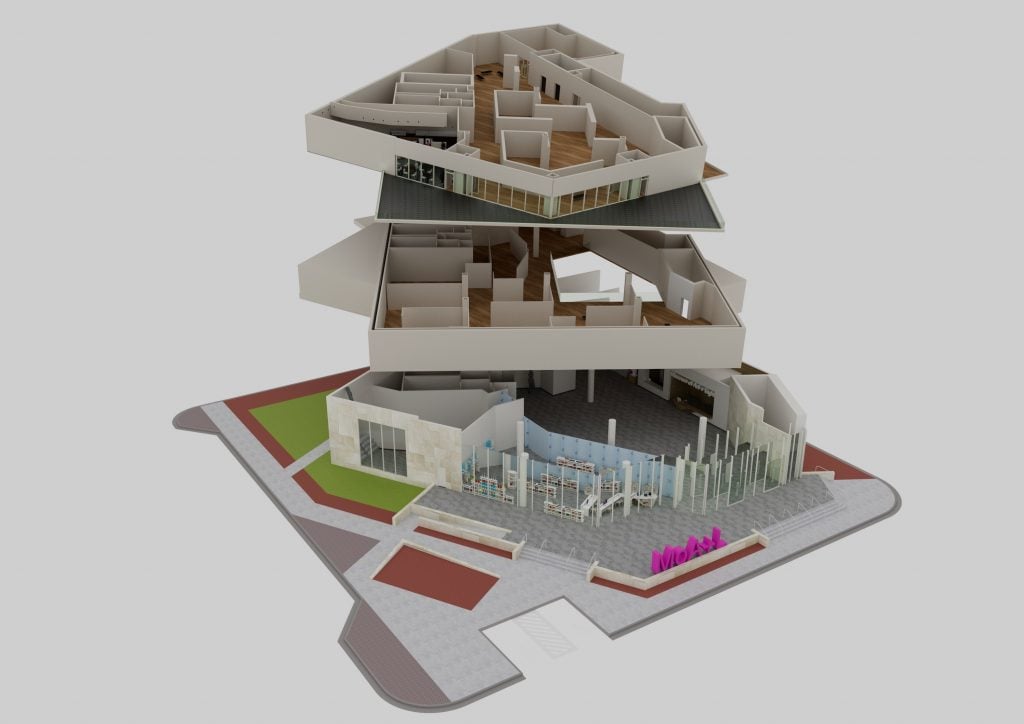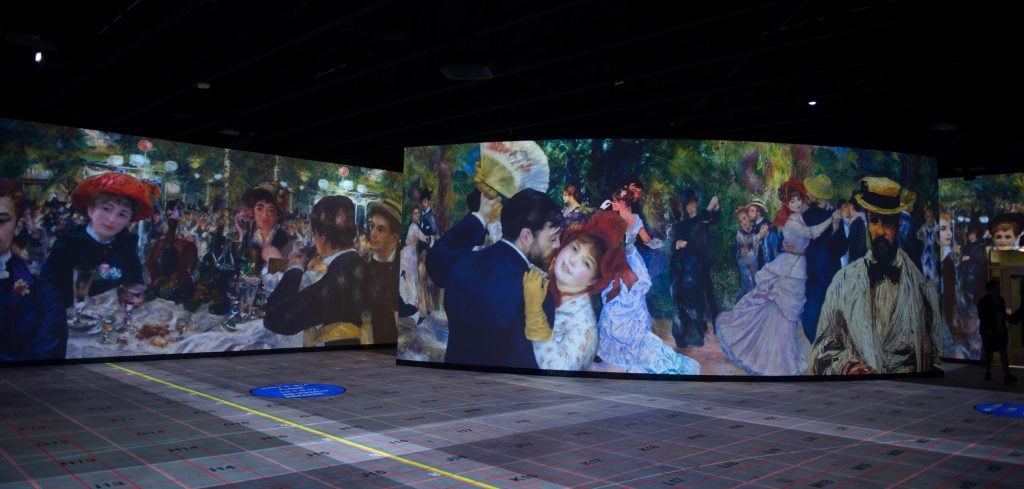Museums & Institutions
Kansas Is Getting an Immersive Museum, Complete With a Digital Art Wing
The museum anticipates up to 175,000 visitors per year.

Can the Bilbao effect take hold in an American prairie town? This is one looming question as construction nears completion on the $60 million Museum of Art + Light (MoA+L) in Manhattan, Kansas.
Two decades ago, the Guggenheim transformed a post-industrial Basque city into a cultural destination, laying a blueprint that has been copied, with mixed results, ever since. The team behind MoA+L is hoping for a similar impact by building a home for the buzziest facets of the art world in a college town with a population of 55,000. And why not? This Manhattan, after all, calls itself the Little Apple.
When MoA+L opens in November it will boast a state-of-the-art immersive exhibition space and become the first art museum in the world to include a permanent digital art wing. It will also be the only institution of its kind for hundreds of miles.
This is central to MoA+L’s pitch. A recent survey from the American Alliance of Museums (AAM) showed only 26 percent of U.S. institutions are located in rural areas, and it’s parochial to assume people should have to travel to major metropolises to experience contemporary art. At present, rural communities encounter museums sporadically, if at all, through portable exhibitions, but this is insufficient, said the museum’s director, Erin Dragotto.

A rendering of MoA+L. Courtesy Sydney Bouhaniche/MoA+L.
“We believe our geographic location, where there may be limited access to arts and culture, coupled with a mission to embrace 21st-century technologies, provide the perfect opportunity to connect with rural communities in a museum setting,” she said.
The link to Manhattan is also personal. The four founders, Robert and Tracey DeBruyn on the arts and education side, and Ron Bowman and Stanley Zukowfsky on the construction side, all began their careers in the town and express a desire to give back to the community.
But such benevolence is also tempered by clear-eyed thinking. Dragotto cited a 2023 report by the Bureau of Economic Analysis that ranked Kansas as the fastest-growing economy in the nation. The museum’s own feasibility study suggests a tourism windfall could be imminent. Kansas and its surrounding five states have a pool of roughly 1.1 million art museum visitors, and MoA+L is expecting up to 175,000 annually.
“We anticipate the impact to be huge,” said Marcia Rozell, director of Visit Manhattan. “The influx of visitors will boost the local economy by increasing traffic to our businesses. It will also enrich the social fabric of the community and enhance Manhattan’s reputation as a vibrant cultural destination.”

An installation view of “Renoir: A Luminous Evolution.” Photo courtesy Museum of Art + Light.
MoA+L’s big bet is on the enduring popularity of immersive experiences. The same AAM study revealed that two-thirds of museums have yet to achieve pre-2020 attendance levels. Immersive experiences, by contrast, are on the rise, bridging art and entertainment with casual atmospheres and Instagram-ready backdrops. Such experiences have been landing nearby, with Kansas City recently hosting shows devoted to Van Gogh, Disney, and King Tut.
Backed by a team of 3D motion graphics designers, MoA+L calls its first floor space The Mez, a 21,500-foot environment decked out with more than 100 projectors. Renoir is first up. Visitors will be submerged in more than 300 of the Impressionist’s florid works and peek into his personal life through family photos and homespun films. It’s a contemporary approach to spotlighting an old favorite, or, as the museum put it on social media, “storytelling + immersive = key to paying homage to one of the greats.”
The statement MoA+L makes on the floor above, however, is even bolder: De Coded, a permanent home for digital art—or, dare we say it, NFTs. The museum considers the space a “laboratory” in which leading digital artists will be invited to create, display, and sell work, with proceeds split between creator, museum, and Iconic, a digital art platform and MoA+L partner. Its first venture, a release by Grant Yun, sold out in seconds.
Is placing confidence in a notoriously volatile corner of the art world risky? Chris Cummings, Iconic’s founder, doesn’t think so. For evidence, he begins by pointing to digital art’s 60-year history. True, the algorithmic outputs of Vera Molnár, Harold Cohen, and Manfred Mohr long predate 2021’s NFT boom, but De Coded’s first cohort is decidedly contemporary and includes generative art mainstays Tyler Hobbs, Snowfo, and Emily Xie.
Fittingly, Cummings connected with MoA+L after giving a talk at a MuseumNext event on the future of museums, in which he argued that the growth of digital art is inevitable.
“Today’s children are growing up in a fully digital environment,” Cummings said. “For them, engaging with digital art will be as natural as previous generations’ engagement with paintings or sculpture. It’s a medium that speaks the language of our time.”





